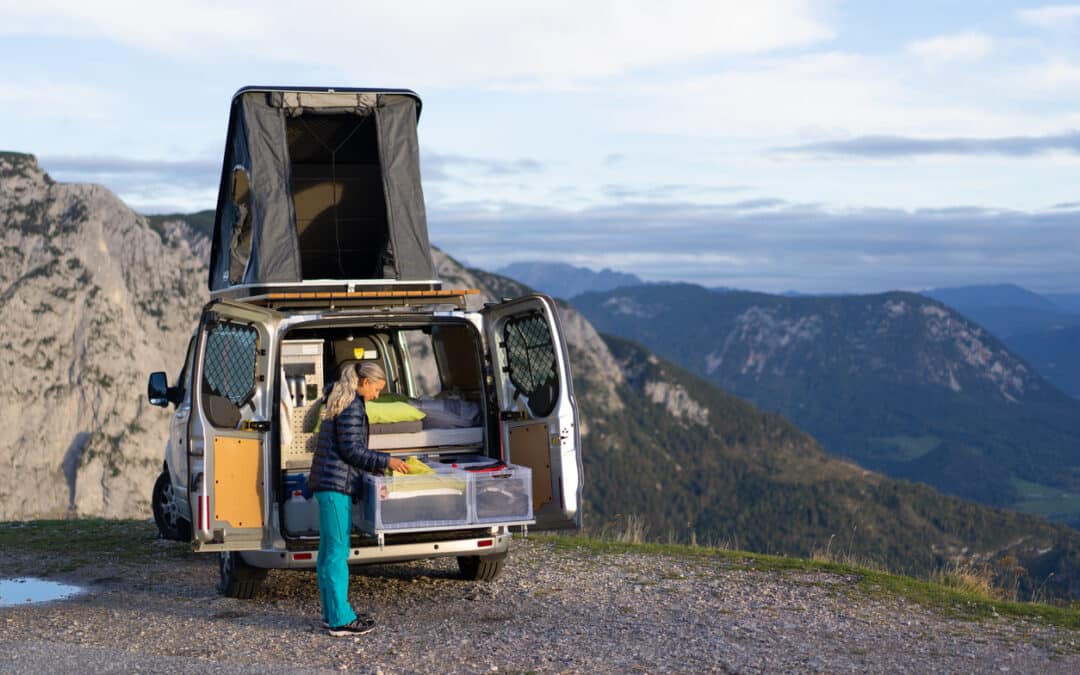#Vanlife – if you haven’t heard about it, seen glamour photos on your favorite social media app, or known at least one Gen-Z-er or Millennial obsessed with the idea, you may be living under a rock.
Vanlife and full-time RVing are increasingly popular lifestyle decisions for people who want to sell their home (or let their lease expire) for a nomadic lifestyle.
It’s easy to dismiss “van life” as a fad, but the reality is with increasing remote work opportunities and the “gig economy,” rising real estate prices, and the embrace of minimalism, this nomadic trend seems to be on the rise. As of the writing of this article, #vanlife has more than 14 Million posts on Instagram.
But Vanlife-ing isn’t just for the (relatively) younger generations. Over 1 Million Americans live in RVs full-time, and the #1 generation engaged in this lifestyle is Baby Boomers, with over 20% of full-time RV-ers being 55 or older.
8 Things to Consider Before Living in a Van or RV Full-Time
If you’re considering selling your home or letting your lease expire in favor of moving to a full-time van life or RV living, there are a few things you will want to consider. From budgeting to maintenance, lifestyle, and more, #vanlife may come with some surprises if you’re not fully prepared.
1. It Costs Thousands of Dollars to Convert a Van (or Buy an RV)
Most #vanlifers have to invest a lot of money into converting their vans to fully livable quarters. Professional van conversion can cost anywhere from $60,000 to $250,000 depending on the final product. Most of these conversions include running water, solar panels, working kitchen appliances, WiFi, as well as a reasonable living and storage area. Of course, there’s always the opportunity to DIY the conversion, though this takes some technical know-how and engineering skills. Keep in mind that these van conversion costs are on top of the average $40,000 to $65,000 for a new panel-style van.
RVs, on the other hand, come with features made for comfort and convenience, usually with a kitchen, bedroom, bathroom, dining space, and often additional sleeping areas or sitting areas. These vehicles are more expensive than vans, costing anywhere from $50,000 to $200,000 (or as high as $500,000 for luxury models) for Class A RVs.
2. Cost of Living is Usually Higher than Expected
In addition to the cost of the actual vehicle and conversion, if required, there is the regular cost of living associated with living in an RV or van full-time. Besides vehicle payments, you can expect to pay campsite fees, fuel, RV/vehicle payments, insurance, maintenance, repairs, groceries, mobile phones, WiFi, and daily costs such as food and supplies. Some van lifers have been known to spend as little as $800/month by staying at free boondocking sites and cooking their own meals, while the more typical full-time RV or van-lifer can expect to pay $2000 to $3000 per month in living expenses.
3. Most RVers Live in Trailer Parks or RV Parks
Although Instagram paints a pretty picture of traveling constantly across the country, the reality is that this constant travel is exhausting and expensive. Gas can cost over $500/month depending on the distance you travel, and campsites, which typically cost $30 to $75/night can cost as much as $1500/month for the site alone. Most full-time RVers live at trailer parks or RV parks, especially in Florida and California.
In contrast, an RV park typically costs closer to $300 to $500/month (though some may be as much as $1500 for exclusive, popular sites) while saving on gas costs.
4. You Need a Legal Address
Even if you live on the road, a “domicile state” is required. This is because you need a legal address to determine where you pay taxes, vote, register vehicles, and get your mail. If you own additional property, this will likely be the domicile you claim, otherwise, you will need to find a family member to allow you to legally “move in” to their residence so you may claim it for legal purposes. There are also services you can use to establish domicile if you don’t have a different residence you can use for that purpose.
If you’re “roadschooling” your children, you will also need to ensure you are familiar with the homeschooling rules of your domicile state.
5. Your Lifestyle Will Change
Because of the lack of space in a van or RV, you probably won’t be spending as much time indoors as you do when you live in a home such as a house or apartment. You may find yourself farther from grocery stores, markets, or entertainment than you’re used to, and everyday conveniences such as laundry and heating/cooling are more difficult to come by.
If you haven’t spent a significant amount of time in an RV or van before—and in all different seasons and types of weather—then it can be a good idea to take an extended trip (think a month or two) to really get a feel for life on the road.
6. Spare Parts & Maintenance Supplies are a Must-Have
Life on the road can be rough, especially if you’re regularly on the move. It’s important to stock up on spare parts and maintenance supplies such as motor oil, propane, furnace parts, hose clamps, nuts/bolts/screws/washers, tire inflators, a tow bar, and antifreeze, etc.—and to know how to use them.
RVs are notorious for having parts break relatively frequently. If you aren’t handy around a vehicle or aren’t comfortable learning how to maintain and repair your van or RV on your own, you should set aside (a lot) of money for repairs.
7. Connectivity can be an Issue
Those who are new to full-time RV or van life may be surprised to find how difficult it may be to find a good WiFi connection for work or school. If you’re depending on Internet for income or education, ensure you have a plan for finding WiFi and that you have the tools needed to improve this connectivity, such as mobile hotspots and boosters.
8. Say Goodbye to Space and Privacy
Many full-time RV or vanlifers are surprised by how long it takes to get used to the reduced space—and privacy. Let’s face it, vans and RVs are a lot smaller than the average apartment, condo, or home. One of the reasons people love the idea of living in an RV or van full-time is because they value the need to minimalize—and stay minimalized. However, if you haven’t lived a minimalist lifestyle before, it will likely be an adjustment. “Space and privacy are gone when you decide to live in an RV. But, the tradeoff of nature and travel are worth it. I will say it took me almost 5 years to find the right RV and feel comfortable being in my RV full time,” says full-time RV resident, Brandi.
Is Living in a Van or RV Full-Time Right for You?
Regardless of your “Why,” it’s important to take the time to consider—and test—the full-time RV theory before you sell off your assets and invest in a large motor vehicle. It can be a good idea to explore the good, the bad, and the ugly online, including through blogs, YouTube, and social media. You may also consider renting a motorhome for a month or two to really get a feel for the lifestyle. Talk to other Vanlifers or full-time RV residents, and consider talking to your financial advisor to ensure your financial strategy can align with your new lifestyle.












